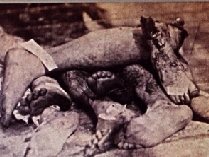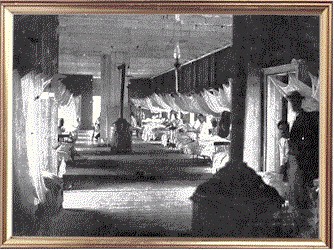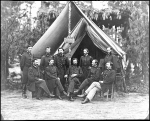| This was the greatest war ever fought in America and Iím here to tell
you why some men lived and why many men died. In four years of conflict,
sixty- thousand men died of wounds received in battle, about six times
that number died of disease. Amputations accounted for seventy- five
percent of all operations performed by Civil War doctors. Quite often
the treatment for a soldier did more harm than good. Quinine was
one of the widely used drugs in the war, usually used for malaria.
The hospitals were very unsanitary causing lots of diseases. Surgeons
would sometimes go a week without washing their saws and knives from the
amputations because they did not know how to sterilize their equipment. |
|
| During the period before the Civil War, a physician received minimal
training. Almost all the older doctors were apprentices of formal
education. There were very few medical schools at that time, and
even those who attended one of them were many times poorly trained.
The average medical student in the United States was trained for two years
or less, they received hardly any clinical experience, and they werenít
given any laboratory instruction. Civil War doctors were commonly
referred to as butchers. Most of the Civil War doctors were younger
physicians and they usually had a degree in medicine although that could
be deceiving. The schooling for a medical student only took two years.
During the Civil War the doctors would treat nearly ten million cases of
illness and injury in just forty- eight months. |

|
| The principal painkillers were opiates- such as landanum or the more
potent morphine. Another favorite drug was calomel, a compound of
mercury used as a cathartic. There wasnít any kind of medicine that
could cure dysentery or diarrhea. Two times the men died of diarrhea
than of battle wounds. |
|
| When a surgeon amputated something he would first anesthezize the patient
with either ether or chloroform. Then the surgeon would cut off the
blood flow to the wounded area with a tourniquet, cut away skin and tissue
with scalpels and amputating knives. Then they would scrape the bone
clean with a rasperator and severed it with a surgical saw. Next
the surgeon would grasp the blood vessels with a tenaculum, and then tie
them off with silk thread, smoothed the stoup with gouging forceps and
sutured the flaps closed. |
|
| Many diseases in the Civil War were caused by dirty water from ponds
and streams. Bowel disorders constituted the soldiers most
common complaint, which is inferred to as diarrhea. Soldiers also
ate food that wasnít always edible which caused even more disease to spread.
Simple colds in the war led to pneumonia and bronchitus. If a patient
wasnít treated within forty- eight hours of being wounded, he was likely
not to live because infection would begin to spread. One thought
to be beneficial for the widest ailments, was alcohol, usually in the form
of whiskey and brandy. Whiskey was thought to counteract shock. |
|
| The casualties were divided into three categories: The mortally
wounded, the slightly wounded, and those requiring surgery. The men
with minor wounds were tended to by a dressing surgeon and given opiates
or liquor. Nearly one third of the soldiers that died in the Civil
War died of wounds received in battle. Nearly two thirds died of
disease or infection which is approximately four hundred thousand men that
died of diseases. |
|
| For example the 12th Connecticut army marched off with a thousand men
and by the time they got ready for their first battle only six hundred
men were left because they had died of diseases. More Americans died
in the Civil War than in any other war ever fought and the saddest part
is that two thirds of the men that fought died because of disease, not
because of deadly wounds received in battle, but because ther wasnít enough
understanding of medicine and the causes of infection! |



